belt CHEVROLET EXPRESS CARGO VAN 2007 1.G Owner's Manual
[x] Cancel search | Manufacturer: CHEVROLET, Model Year: 2007, Model line: EXPRESS CARGO VAN, Model: CHEVROLET EXPRESS CARGO VAN 2007 1.GPages: 458, PDF Size: 2.62 MB
Page 33 of 458
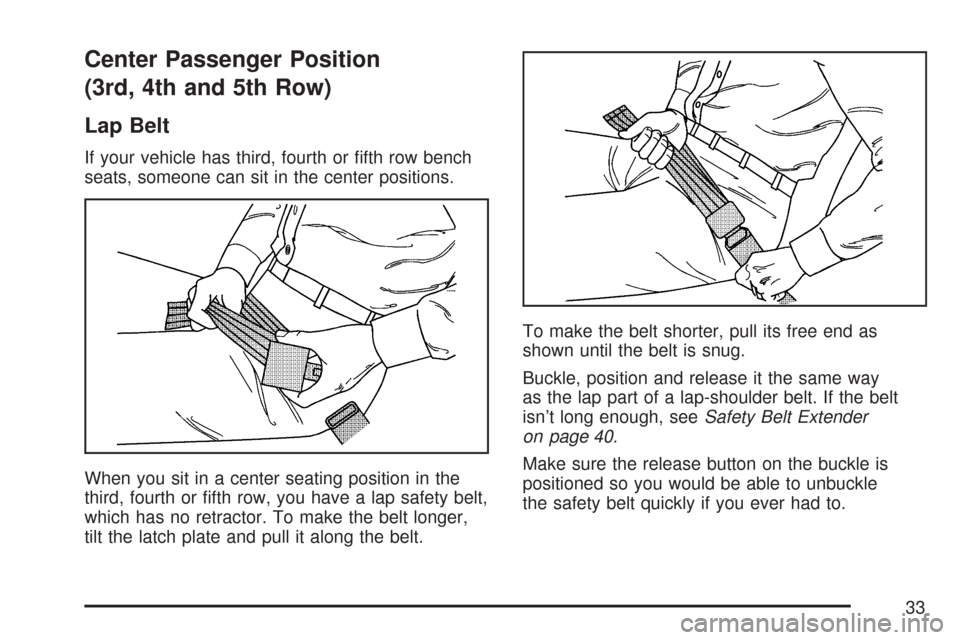
Center Passenger Position
(3rd, 4th and 5th Row)
Lap Belt
If your vehicle has third, fourth or fifth row bench
seats, someone can sit in the center positions.
When you sit in a center seating position in the
third, fourth or fifth row, you have a lap safety belt,
which has no retractor. To make the belt longer,
tilt the latch plate and pull it along the belt.To make the belt shorter, pull its free end as
shown until the belt is snug.
Buckle, position and release it the same way
as the lap part of a lap-shoulder belt. If the belt
isn’t long enough, seeSafety Belt Extender
on page 40.
Make sure the release button on the buckle is
positioned so you would be able to unbuckle
the safety belt quickly if you ever had to.
33
Page 34 of 458
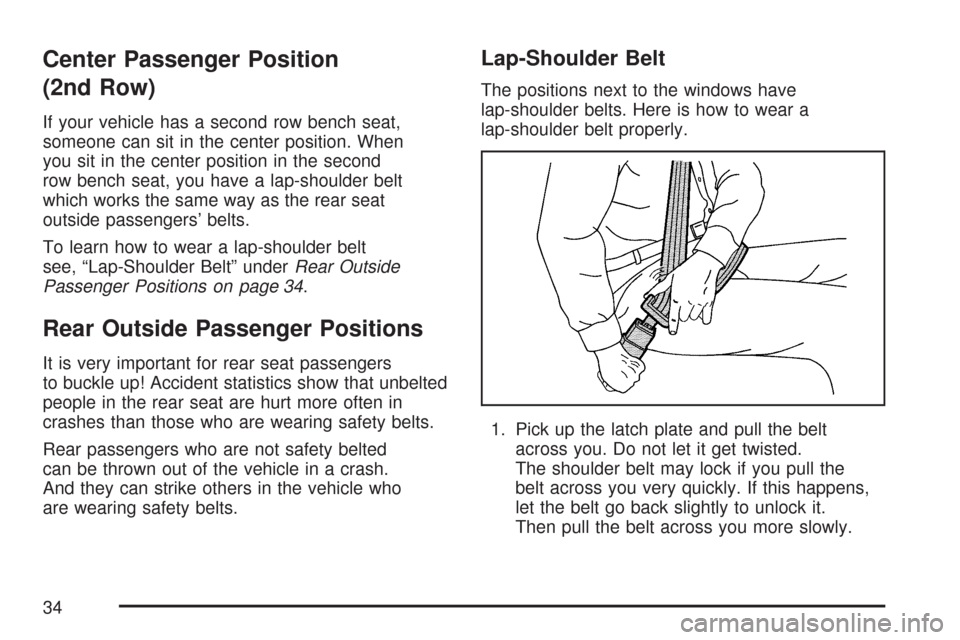
Center Passenger Position
(2nd Row)
If your vehicle has a second row bench seat,
someone can sit in the center position. When
you sit in the center position in the second
row bench seat, you have a lap-shoulder belt
which works the same way as the rear seat
outside passengers’ belts.
To learn how to wear a lap-shoulder belt
see, “Lap-Shoulder Belt” underRear Outside
Passenger Positions on page 34.
Rear Outside Passenger Positions
It is very important for rear seat passengers
to buckle up! Accident statistics show that unbelted
people in the rear seat are hurt more often in
crashes than those who are wearing safety belts.
Rear passengers who are not safety belted
can be thrown out of the vehicle in a crash.
And they can strike others in the vehicle who
are wearing safety belts.
Lap-Shoulder Belt
The positions next to the windows have
lap-shoulder belts. Here is how to wear a
lap-shoulder belt properly.
1. Pick up the latch plate and pull the belt
across you. Do not let it get twisted.
The shoulder belt may lock if you pull the
belt across you very quickly. If this happens,
let the belt go back slightly to unlock it.
Then pull the belt across you more slowly.
34
Page 35 of 458
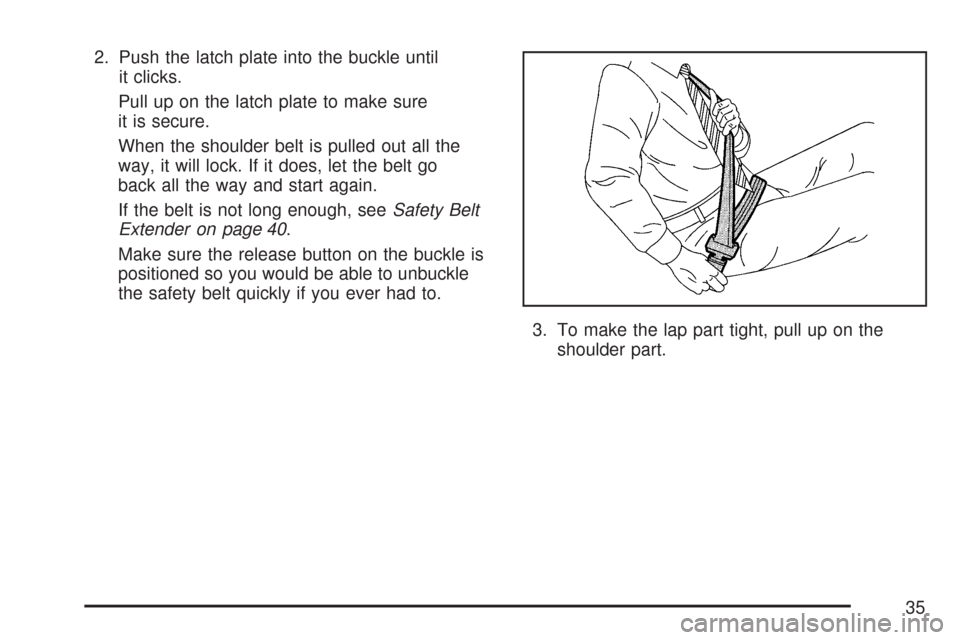
2. Push the latch plate into the buckle until
it clicks.
Pull up on the latch plate to make sure
it is secure.
When the shoulder belt is pulled out all the
way, it will lock. If it does, let the belt go
back all the way and start again.
If the belt is not long enough, seeSafety Belt
Extender on page 40.
Make sure the release button on the buckle is
positioned so you would be able to unbuckle
the safety belt quickly if you ever had to.
3. To make the lap part tight, pull up on the
shoulder part.
35
Page 36 of 458
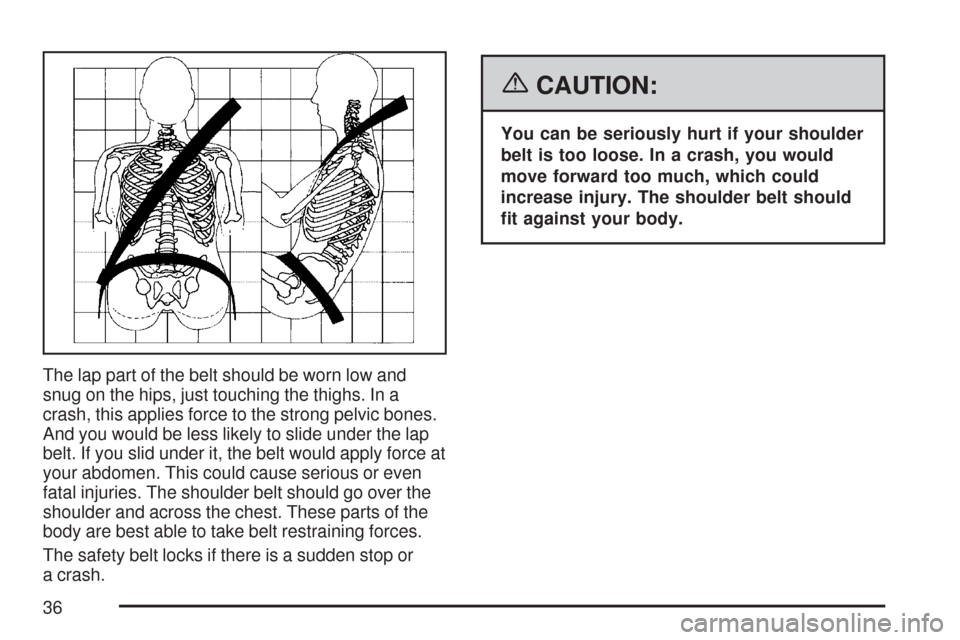
The lap part of the belt should be worn low and
snug on the hips, just touching the thighs. In a
crash, this applies force to the strong pelvic bones.
And you would be less likely to slide under the lap
belt. If you slid under it, the belt would apply force at
your abdomen. This could cause serious or even
fatal injuries. The shoulder belt should go over the
shoulder and across the chest. These parts of the
body are best able to take belt restraining forces.
The safety belt locks if there is a sudden stop or
a crash.
{CAUTION:
You can be seriously hurt if your shoulder
belt is too loose. In a crash, you would
move forward too much, which could
increase injury. The shoulder belt should
�t against your body.
36
Page 37 of 458
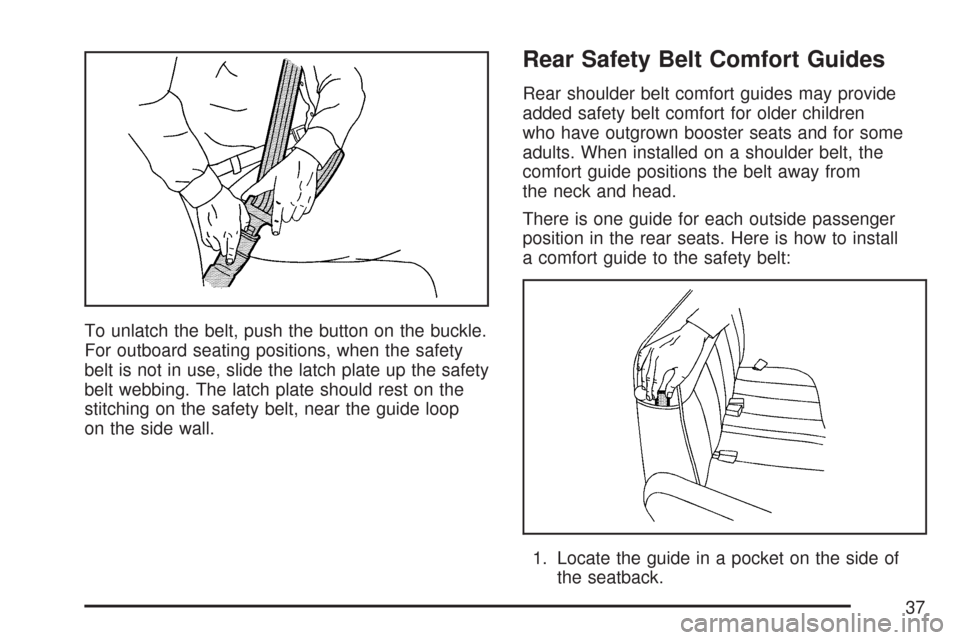
To unlatch the belt, push the button on the buckle.
For outboard seating positions, when the safety
belt is not in use, slide the latch plate up the safety
belt webbing. The latch plate should rest on the
stitching on the safety belt, near the guide loop
on the side wall.
Rear Safety Belt Comfort Guides
Rear shoulder belt comfort guides may provide
added safety belt comfort for older children
who have outgrown booster seats and for some
adults. When installed on a shoulder belt, the
comfort guide positions the belt away from
the neck and head.
There is one guide for each outside passenger
position in the rear seats. Here is how to install
a comfort guide to the safety belt:
1. Locate the guide in a pocket on the side of
the seatback.
37
Page 38 of 458
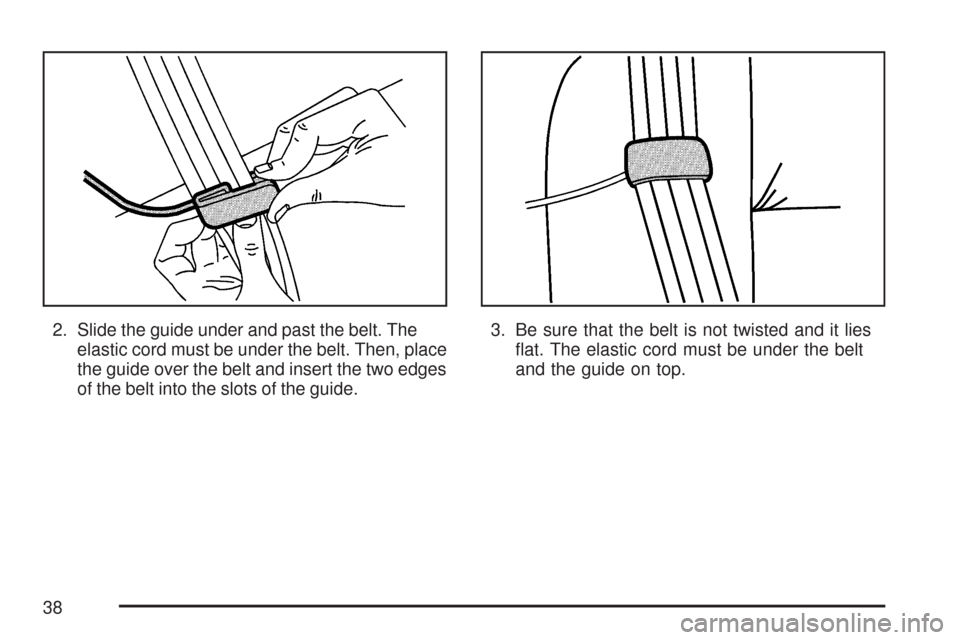
2. Slide the guide under and past the belt. The
elastic cord must be under the belt. Then, place
the guide over the belt and insert the two edges
of the belt into the slots of the guide.3. Be sure that the belt is not twisted and it lies
flat. The elastic cord must be under the belt
and the guide on top.
38
Page 39 of 458
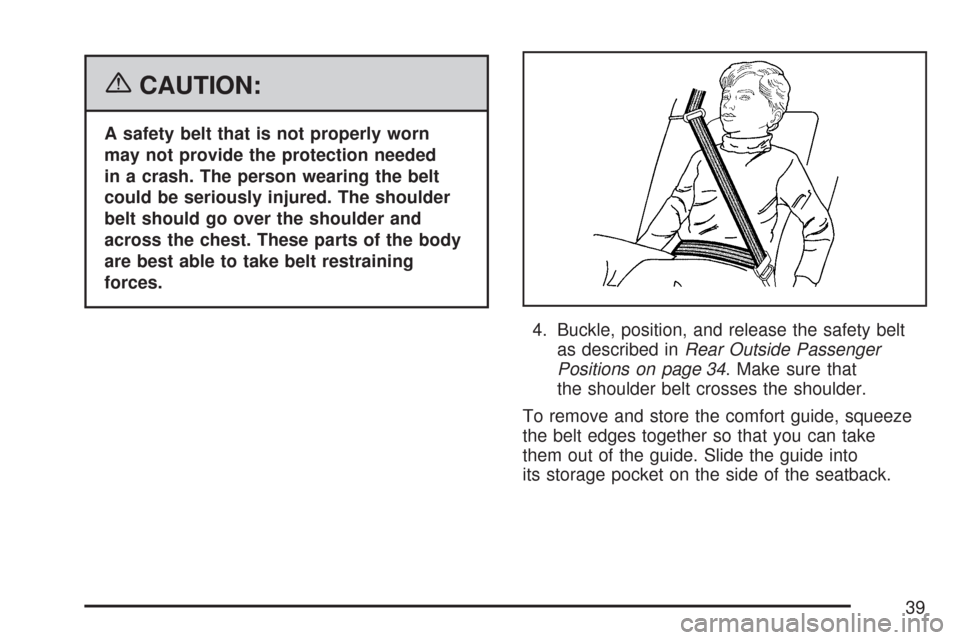
{CAUTION:
A safety belt that is not properly worn
may not provide the protection needed
in a crash. The person wearing the belt
could be seriously injured. The shoulder
belt should go over the shoulder and
across the chest. These parts of the body
are best able to take belt restraining
forces.
4. Buckle, position, and release the safety belt
as described inRear Outside Passenger
Positions on page 34. Make sure that
the shoulder belt crosses the shoulder.
To remove and store the comfort guide, squeeze
the belt edges together so that you can take
them out of the guide. Slide the guide into
its storage pocket on the side of the seatback.
39
Page 40 of 458
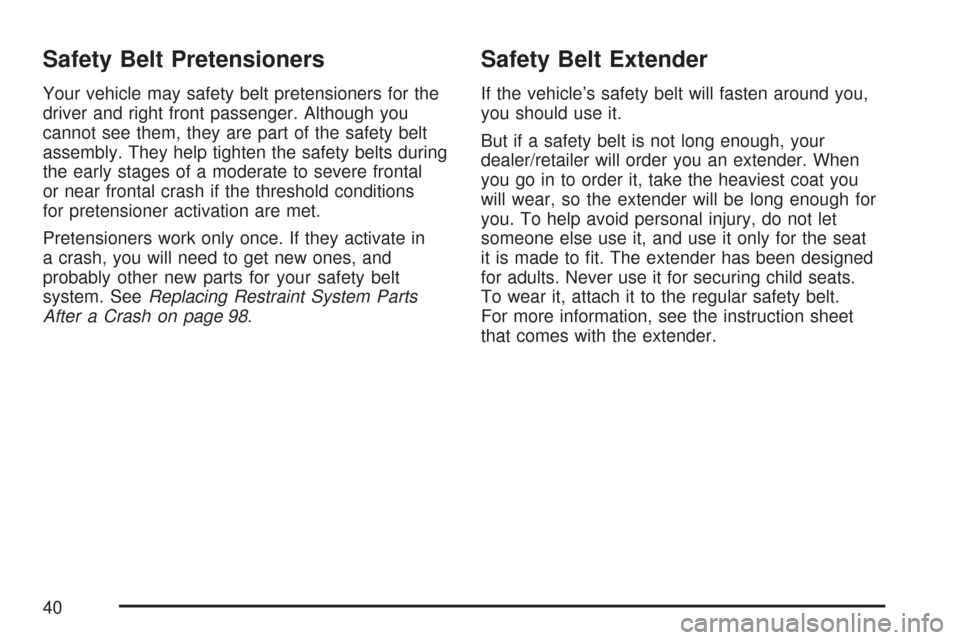
Safety Belt Pretensioners
Your vehicle may safety belt pretensioners for the
driver and right front passenger. Although you
cannot see them, they are part of the safety belt
assembly. They help tighten the safety belts during
the early stages of a moderate to severe frontal
or near frontal crash if the threshold conditions
for pretensioner activation are met.
Pretensioners work only once. If they activate in
a crash, you will need to get new ones, and
probably other new parts for your safety belt
system. SeeReplacing Restraint System Parts
After a Crash on page 98.
Safety Belt Extender
If the vehicle’s safety belt will fasten around you,
you should use it.
But if a safety belt is not long enough, your
dealer/retailer will order you an extender. When
you go in to order it, take the heaviest coat you
will wear, so the extender will be long enough for
you. To help avoid personal injury, do not let
someone else use it, and use it only for the seat
it is made to fit. The extender has been designed
for adults. Never use it for securing child seats.
To wear it, attach it to the regular safety belt.
For more information, see the instruction sheet
that comes with the extender.
40
Page 41 of 458
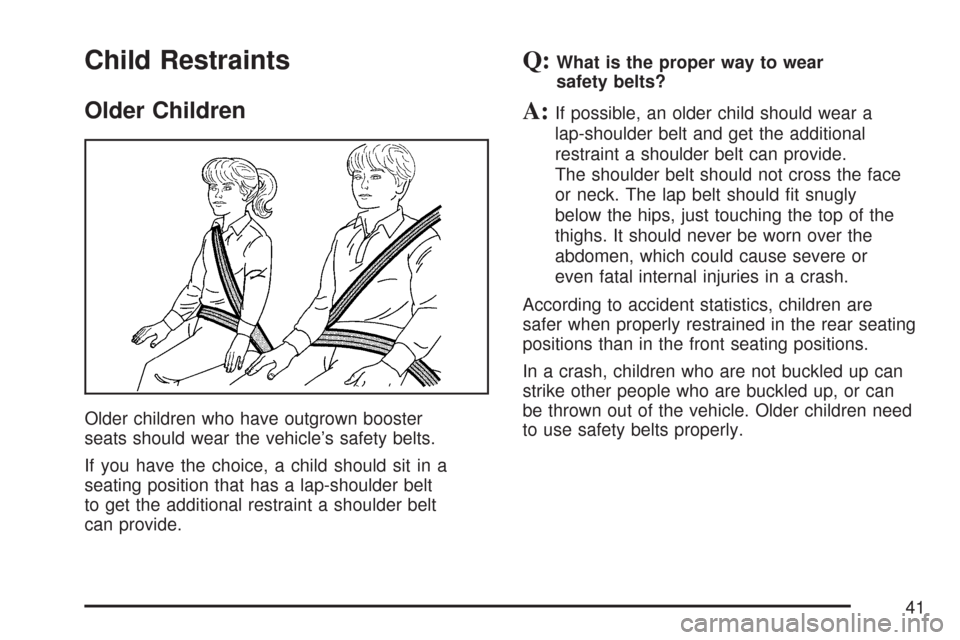
Child Restraints
Older Children
Older children who have outgrown booster
seats should wear the vehicle’s safety belts.
If you have the choice, a child should sit in a
seating position that has a lap-shoulder belt
to get the additional restraint a shoulder belt
can provide.
Q:What is the proper way to wear
safety belts?
A:If possible, an older child should wear a
lap-shoulder belt and get the additional
restraint a shoulder belt can provide.
The shoulder belt should not cross the face
or neck. The lap belt should fit snugly
below the hips, just touching the top of the
thighs. It should never be worn over the
abdomen, which could cause severe or
even fatal internal injuries in a crash.
According to accident statistics, children are
safer when properly restrained in the rear seating
positions than in the front seating positions.
In a crash, children who are not buckled up can
strike other people who are buckled up, or can
be thrown out of the vehicle. Older children need
to use safety belts properly.
41
Page 42 of 458
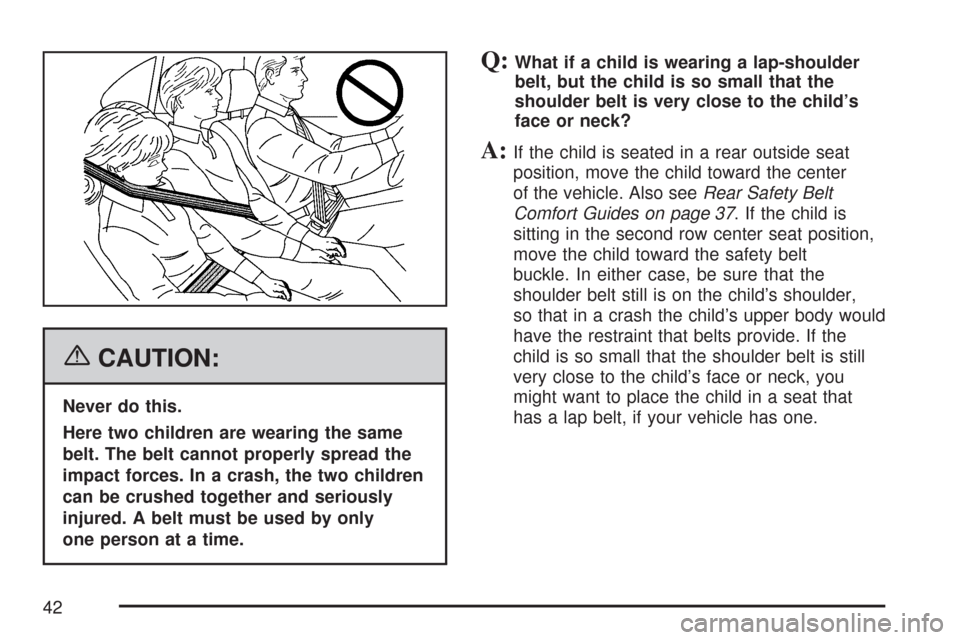
{CAUTION:
Never do this.
Here two children are wearing the same
belt. The belt cannot properly spread the
impact forces. In a crash, the two children
can be crushed together and seriously
injured. A belt must be used by only
one person at a time.
Q:What if a child is wearing a lap-shoulder
belt, but the child is so small that the
shoulder belt is very close to the child’s
face or neck?
A:If the child is seated in a rear outside seat
position, move the child toward the center
of the vehicle. Also seeRear Safety Belt
Comfort Guides on page 37. If the child is
sitting in the second row center seat position,
move the child toward the safety belt
buckle. In either case, be sure that the
shoulder belt still is on the child’s shoulder,
so that in a crash the child’s upper body would
have the restraint that belts provide. If the
child is so small that the shoulder belt is still
very close to the child’s face or neck, you
might want to place the child in a seat that
has a lap belt, if your vehicle has one.
42